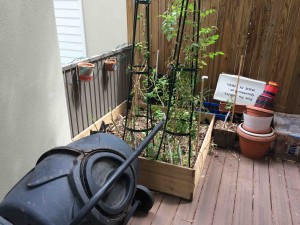Composting is hard. It sounds easy, but in reality, it takes work and there are a lot of variables that impact on the microbiological safety of the final product. Because we live in central Brisbane in an all concrete townhouse, I have pots and raised beds that grow herbs and veggies that primarily feed possums at night. But I do  compost, to cut down on the amount of rubbish going to the street, in this groovy rotator that works well as long as it is turned several times a day.
compost, to cut down on the amount of rubbish going to the street, in this groovy rotator that works well as long as it is turned several times a day.
Erickson et al. report that in two separate studies were conducted to address the condition and the type of feedstocks used during composting of dairy manure. In each study, physical (temperature), chemical (ammonia, volatile acids, and pH), and biological (Salmonella, Listeria monocytogenes, and Escherichia coli O157:H7) parameters were monitored during composting in bioreactors to assess the degree to which they were affected by the experimental variables and, ultimately, the ability of the chemical and physical parameters to predict the fate of pathogens during composting.
Compost mixtures that contained either aged dairy manure or pine needles had reduced heat generation; therefore, pathogen reduction took longer than if fresh manure or carbon amendments of wheat straw or peanut hulls were used. Based on regression models derived from these results, ammonia concentration, in addition to heat, were the primary factors affecting the degree of pathogen inactivation in compost mixtures formulated to an initial carbon-nitrogen (C:N) ratio of 40:1, whereas, the pH of the compost mixture along with the amount of heat exposure were most influential in compost mixtures formulated to an initial C:N ratio of 30:1. Further studies are needed to validate these models so that additional criteria in addition to time and temperature can be used to evaluate the microbiological safety of composted manures.
Inactivation of pathogens during aerobic composting of fresh and aged dairy manure and different carbon amendments
Erickson, Marilyn C.; Liao, Jean; Jiang, Xiuping; Doyle, Michael P.
Journal of Food Protection®, Number 11, November 2014, pp. 1844-2003, pp. 1911-1918(8)
http://www.ingentaconnect.com/content/iafp/jfp/2014/00000077/00000011/art00010
